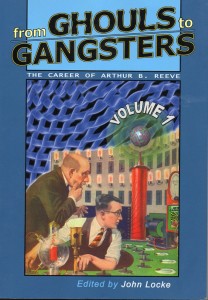Book Review: From Ghouls to Gangsters: The Career of Arthur B. Reeve Volume 1 edited by John Locke
Arthur B. Reeve (1880-1936) was a newspaper reporter who decided to try his hand at writing fiction. As it happened, he turned out to be very good at it, making a huge hit with his most famous character, scientific detective Craig Kennedy. He became America’s most popular detective story writer from 1910-1920, and continued to do pretty well thereafter (despite a bankruptcy when a man who’d commissioned a bunch of work failed to pay) until his death. Mr. Reeve also worked on films and radio, and did true crime reporting as well.
This first volume is a collection of short stories; the second volume has non-fiction by and about Mr. Reeve. The first story appears to be his first sale, “The Cat that Didn’t Come Back” (1907), a gruesome but comedic tale of a man attempting to dispose of a cat’s corpse. The majority of stories are about Craig Kennedy, a professor of chemistry who decides to use his knowledge of science to solve crimes. He’s assisted by newspaper reporter Walter Jameson, the Watson-like narrator.
We begin with the 1910 story “The Case of Helen Bond.” A man has died of a heart attack, but the fact that his safe was burgled the same night casts a suspicion of foul play. Mr. Kennedy uses a primitive type of lie detector (and his brain) to crack the case. The professor owes a great deal to Sherlock Holmes, but is considerably less eccentric. In the Holmes tradition, the reader is not given all the clues, but must wait for Mr. Kennedy to sum up the case and how the science plays in.
That story was published in Cosmopolitan, but Kennedy stories appeared in many places, including Boys’ Life (which introduced a young nephew for him) and Country Gentleman. By the 1930s, Mr. Reeve’s stories mostly appeared in the detective pulps, and took on a more “gangbusters” feel. He was also beginning to reuse plot beats from earlier, out of print stories.
The science in some of the stories is a bit dated, particularly the case that’s solved by Freudian dream analysis. As well, period ethnic prejudice pops up from time to time. Mr. Reeve appears to have been progressive in his views of women for 1910, but some bits look odd from a modern perspective.
Mr. Reeve wrote several stories with female protagonists as detectives, including medical Dr. Mary Mannix and “secret agent” Clare Kendall. One of the latter’s stories closes out the volume, “The Royal Racket” (1935). Clare helps identify two corpses, and is then asked to advise a young couple that suspects some of their new social crowd might be less than honest. The two cases are of course connected.
The Boys’ Life story “The Polar Flight of the ZR-10” (1924) is notable for not being so much a mystery as a speculative fiction story. The title dirigible is being used to test a transpolar flight route between America and Europe, and finds a long-lost colony of Vikings. The mystery subplot arises from a “beat the Reds” race that feels more 1950s than 1920s.
Overall, the stories are good, if mostly dated, and demonstrate Mr. Reeve’s ability to write to a specific magazine’s intended audience. Most of the earlier stories were heavily edited for book publication to make them pseudo-novels, and the later ones have never been reprinted before, which makes this a good collector’s item for detective story fans.

